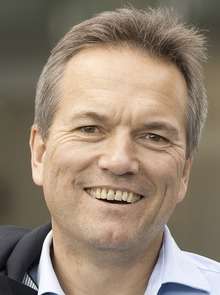Matthias Hentze
| Prof. Dr. Matthias Hentze | |
|---|---|
 | |
| Born |
January 25, 1960 Wiedenbrück, Germany[1] |
| Residence | Heidelberg, Germany |
| Citizenship | German |
| Nationality | German |
| Fields | Molecular Biology, RNA-binding proteins |
| Institutions | |
| Alma mater | Westfälische Wilhelms-Universität Münster |
| Thesis | "Influence of amino acid analogs on maturation, transport and stability of cathepsin D in human skin fibroblasts" (1984) |
|
Website www.embl.de | |
Matthias Werner Hentze, MD (born 25 January 1960 in Wiedenbrück, West Germany) is a German scientist. Currently, he is the Director of the European Molecular Biology Laboratory (EMBL)[4] and Professor of Molecular Medicine at Heidelberg University.[5]
Biography
Matthias Hentze studied medicine in the UK at the medical schools at the University of Southampton, University of Oxford, University of Glasgow and University of Cambridge, and in Germany at the Westfälische Wilhelms-Universität, Münster from which he qualified in 1984.[1] In the same year, he received his M.D. degree for work on lysosomal enzyme biogenesis in the laboratory of Prof. Kurt von Figura.[1][6][7]
After a short phase of clinical work and supported by a fellowship awarded by the Deutsche Forschungsgemeinschaft (German Research Council),[8] Hentze became a postdoctoral fellow in Dr. Richard Klausner’s laboratory at the National Institutes of Health (NIH), Bethesda, Maryland, United States in 1985.[9] In 1989, he joined the European Molecular Biology Laboratory in Heidelberg as an independent group leader.[10] At the age of 30, he obtained the Habilitation from the Ruprecht-Karls University in Heidelberg.[1] He served as Dean of the EMBL International Ph.D. Programme from 1996 until 2005, when he became Associate Director of the EMBL and Professor for Molecular Medicine at the University of Heidelberg.[1] Together with Prof. Andreas Kulozik of the Medical Faculty of Heidelberg University, Hentze co-founded the Molecular Medicine Partnership Unit (MMPU) in 2002 and serves as its Co-Director.[11][12] He is also co-founder of Anadys Pharmaceuticals, San Diego, California.[13]
Since 2013, Matthias Hentze is the Director of EMBL, advising and supporting EMBL's Director General, Prof. Iain Mattaj.[4]
He is married and has three daughters.[1]
Research
In 1987, Hentze and his colleagues discovered iron-responsive elements that regulate mammalian mRNA.[14] He has also studied the relationship between iron metabolism and disease and diseases of RNA metabolism, especially those relating to the Nonsense-mediated decay pathway and RNA 3′-end formation. Since around 2010 Hentze has studied RNA-binding enzymes that connect cellular metabolism and gene expression.[15] This research project, which focuses on REM Networks was awarded an ERC Advanced Grant of the European Research Council in 2011[16] and has meanwhile uncovered hundreds of new RNA-binding proteins in the stem cells of mammals and yeast, including 50 metabolic enzymes.[17][18]
Honors and Awards (Selection)
- 2016 — Corresponding Member, Australian Academy of Science[19]
- 2015 — RNA Society, Elected Director (2016-2017)[20]
- 2015 — Feodor Lynen Medal and Lecture, German Society for Biochemistry and Molecular Biology[21][22]
- 2007 — Lautenschläger Research Prize of the University of Heidelberg[23][24]
- 2006 — Elected Member of the German Academy of Sciences - Leopoldina[1][25]
- 2003 — Elected Member of the European Academy of Sciences - EURASC[26]
- 2000 — Gottfried Wilhelm Leibniz Prize of the German Research Foundation (Deutsche Forschungsgemeinschaft)[8][27]
- 1997 — Elected member of the European Molecular Biology Organization (EMBO) [28]
Editorial Boards
- International Advisory Board, Wiley Interdisciplinary Reviews RNA (since 2009) [29]
- Senior Editor, EMBO Molecular Medicine (since 2008) [30]
- Molecular Cell (since 2004) [31]
- J. Molecular Medicine (since 2004) [32]
- BioMed Central Molecular Biology (since 2003) [33]
- RNA (since 1997) [34]
- Trends in Biochemical Sciences [TiBS] (since 1996) [35]
References
- 1 2 3 4 5 6 7 Leopoldina CV. Retrieved 2015-06-12.
- ↑ National Institutes of Health Retrieved 2015-08-06.
- ↑ EMBL Homepage Retrieved 2015-08-06.
- 1 2 EMBL Leadership. Retrieved 2015-06-12.
- ↑ Faculty at Heidelberg University Hospital. Retrieved 2015-06-12.
- ↑ German National Library. Retrieved 2015-07-20.
- ↑ Hentze, M.; Hasilik, A.; Figura, Kurt v. "Enhanced degradation of Cathepsin D synthesized in the presence of the threonine analog beta-hydroxynorvaline". Arch. Biochem. Biophys. 230 (1): 375–82. PMID 6424571. doi:10.1016/0003-9861(84)90120-6. Retrieved 2015-08-06.
- 1 2 DFG German Research Foundation. Retrieved 2015-06-12.
- ↑ TiBS Vol. 37, No. 12. Retrieved 2015-06-12.
- ↑ AARS 2015 - Keynote Speakers. Retrieved 2015-06-12.
- ↑ MMPU at Heidelberg University Hospital. Retrieved 2015-06-12.
- ↑ Nature: Language lessons. May 2003. Retrieved 2015-06-12.
- ↑ Nasdaq.com. Registration statement of Anadys Pharmaceuticals, Inc. Retrieved 2015-06-12.
- ↑ Journal of Molecular Biology (1997) 274. Retrieved 2015-06-12.
- ↑ Life Scientist: Enzymes with alter egos. Feb. 2014. Retrieved 2015-06-12.
- ↑ ERC Website. REM Networks. Retrieved 2015-08-06
- ↑ Castello, Alfredo; Fischer, Bernd; Eichelbaum, Katrin; et al. "Insights into RNA biology from an atlas of mammalian mRNA-binding proteins". Cell. 149 (6): 1393–406. PMID 22658674. doi:10.1016/j.cell.2012.04.031. Retrieved 2015-08-06.
- ↑ Kwon, S Chul; et al. "The RNA-binding protein repertoire of embryonic stem cells". Nature Structural & Molecular Biology. 20 (9): 1122–30. PMID 23912277. doi:10.1038/nsmb.2638. Retrieved 2015-08-06.
- ↑ Australian Academy of Science/News and events. Retrieved 2016-04-05
- ↑ RNA Society. Directors. Retrieved 2016-04-04
- ↑ 66th Mosbacher Kolloquium 2015. Retrieved 2015-06-12.
- ↑ Biospektrum.de. Retrieved 2015-07-20.
- ↑ Lautenschläger-Research Prize 2007 for Prof. Dr. Matthias Hentze and Prof. Dr. Andreas Kulozik. Retrieved 2015-06-12.
- ↑ Biotechnology and Life Sciences in Baden-Württemberg. Retrieved 2015-07-20.
- ↑ Leopoldina. Nationale Akadamie der Wissenschaften. Retrieved 2015-08-06.
- ↑ EURASC Membership Directory. Retrieved 2015-07-20.
- ↑ Gottfried Wilhelm Leibniz Programme 2000. Retrieved 2015-07-20.
- ↑ EMBO Membership Directory. Retrieved 2015-07-20.
- ↑ Wiley Online Library. Retrieved 2015-07-20.
- ↑ EMBO Press - Editors & Advisory Editorial Board. Retrieved 2015-07-20.
- ↑ Cell Editorial Board. Retrieved 2015-07-20.
- ↑ Journal of Molecular Medicine Editorial Board. Retrieved 2015-07-20.
- ↑ BMC Molecular Biology Editorial Board. Retrieved 2015-07-20.
- ↑ RNA Editorial Board. Date retr. 07-20-2015
- ↑ TiBS Editorial Board. Retrieved 2015-07-20.